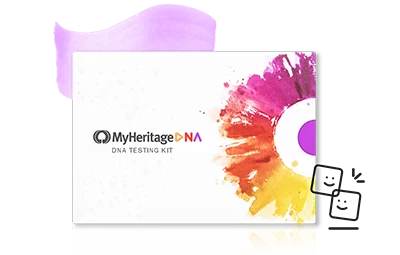
On February 2, 2025, MyHeritage introduced the long-awaited improvement to our DNA ethnicity model: Ethnicity Estimate v2.5!
In this article, we’ll address all the most pressing questions about the ethnicity update and how it will enhance your knowledge of your family history.
What changed in the update?
The new model provides higher-resolution results and nearly doubles the number of ethnicities identified by MyHeritage — from 42 to 79.
For example, individuals whose DNA results previously showed Scandinavian ethnicity will now receive results specifying what percentage of their ethnic makeup is Swedish, Norwegian, or Danish. Someone whose previous results included “North and West European” may now receive results indicating French, Germanic, Dutch, or Breton origins. Ethnicity Estimate v2.5 identifies 24 percentage-based European ethnicities, 15 different Jewish ethnicities, and some that are unique to MyHeritage and not identified by other tests, such as Armenian.

What about Genetic Groups? Have they been affected by the update?
No, your Genetic Groups will remain the same. The algorithm for Genetic Groups remains unchanged in this update. The only difference is that the Genetic Groups you belong to may be nested under a different ethnicity, if that ethnicity is a closer match to the group as a whole. More on this below.
Who is eligible for the update?
If you have received ethnicity results from MyHeritage in the past, either because you took a MyHeritage DNA test or because you uploaded your results and unlocked advanced features, you can opt in to receive your new results for free. The new model supports even older DNA chips, so even if you took your test years ago, you’ll be able to receive v2.5 results. New MyHeritage DNA customers will receive v2.5 results by default.
If you have tested with another DNA company, you can also receive v2.5 results by uploading your DNA data and paying a one-time unlock fee of $29 per kit for access to advanced DNA features. You can also purchase a MyHeritage subscription (Premium, PremiumPlus, Complete, or Omni) to unlock the Ethnicity Estimate for all DNA kits associated with your account.
How can I view my updated results?
If you’re a new MyHeritage DNA user, you’ll receive Ethnicity Estimate v2.5 results from day one. If you’re an existing DNA user who received ethnicity results before, you’ll need to opt in. We understand that change can be challenging and we want everyone to feel comfortable with their results!
To opt in, access your Ethnicity Estimate from the MyHeritage website or mobile app under DNA>Ethnicity Estimate. A pop-up message will appear asking if you would like to update to the new model. Click “Get the update”.

If you click “Maybe later,” you can always opt in later by clicking the banner that appears at the top of your results.
It takes about a day for your new results to be calculated. We’ll email you as soon as they’re ready.
My previous results seemed to align better with what I know about my family history. Which results are more correct?
The new model is based on better data and is more precise, but it’s not perfect. Your DNA Ethnicity Estimate is just one window into your family’s past, and there are many other sources of information that help complete the picture, including historical documents, oral traditions, and confirmed relatives.
What if I prefer my previous results?
We understand that many users may be quite attached to their previous results. That’s why we made the update optional. You can always switch back to Ethnicity Estimate v0.95 — the previous model — via the dropdown menu on the results page.
Why are my new results so different from my previous ones? What happened to my 2% Nigerian?!
Receiving your ethnicity results for the first time can be exhilarating and surprising. You may have learned things about yourself you never imagined, and naturally, you may be fascinated by any unusual or unexpected results. It can be a let-down to see some of those exciting results disappear!
To understand why this happened, you need to understand how the DNA Ethnicity Estimate works. In a nutshell, MyHeritage created a database of “sample” populations with known origins, and identified specific DNA markers that are typical of that population. When you take a DNA test, your DNA is compared to each of those sample populations, and your ethnicity percentages are calculated according to what percentage of your DNA is most similar to each of them. Now that MyHeritage has almost twice as many sample populations to compare to, that might shuffle some things around in your results. Perhaps that 2% of DNA we previously identified as Nigerian was actually part of your Irish DNA. Because our previous model was lower-resolution, the algorithm may not have recognized it as such and assigned it to the “next best guess.”
In short: the new model is more accurate, and that means that previous, less accurate results may no longer appear in your results.
What happened to Sierra Leonean, Maasai, and other ethnicities that were available in the previous model and no longer appear on the list?
The new v2.5 model is better than v0.95, but it isn’t perfect — no ethnicity model is. There are a few ethnicities that were “lost” in the new algorithm due to lack of data. The new model requires more training samples, and a sufficient number of these were not available for these ethnicities. The good news is that even if an ethnicity was “lost,” it may make a comeback in a future update to the algorithm.
Why are my Genetic Groups listed under a different ethnicity now?
Genetic Groups are nested based on a personalized hierarchy. This means that each Genetic Group that you are a member of will be nested under an ethnicity that best fits both that Genetic Group and your own DNA results. While the Genetic Groups themselves didn’t change, the ethnicities associated with them did, and they may have been reassigned accordingly.
For example, the Genetic Group of Malta had a mix of Italian and Greek and South Italian heritage in v0.95. If you are a member of the Maltese group, and had a large percentage of Italian ethnicity in v0.95, the Maltese group was probably nested under your Italian ethnicity. However, if you’re a member of the Maltese group but had Greek and South Italian heritage and no Italian origins, or a higher degree of Greek and South Italian heritage compared to Italian, the same Genetic Group was nested under the Greek and South Italian ethnicity.
With the new update, the Genetic Group of Malta might be nested under Maltese, South Italian, Spanish, Catalan and Basque, or French — depending on the percentages of these ethnicities in your results.

Why is Ethnicity Estimate v2.5 so specific about certain ethnicities and so general about others?
While users of Portuguese descent may celebrate having their own ethnicity now, those of Spanish, Catalan, and Basque descent may be disappointed that their populations are still “lumped together” into a single ethnicity. Why do some ethnicities cover a larger region or more diverse group of people, while some are super specific and granular?
There are a few reasons for this. One of them is that certain populations are so genetically similar that it is very difficult to tell them apart. Another is that the accuracy and detail of an ethnicity estimate are limited by the quality and quantity of the training samples. The more people of a given origin have taken a DNA test, the more information we have on the genetic markers that characterize that population.
Keep in mind that it’s not set in stone: we will continue improving our data and algorithms, and this will allow us to “untangle” certain populations from others. Perhaps in a future update, the model will be able to distinguish between Spanish, Catalan, and Basque DNA in addition to Portuguese. In the meantime, Genetic Groups are there to help you dive deeper into your heritage and pinpoint your ancestors’ origins with greater precision.




